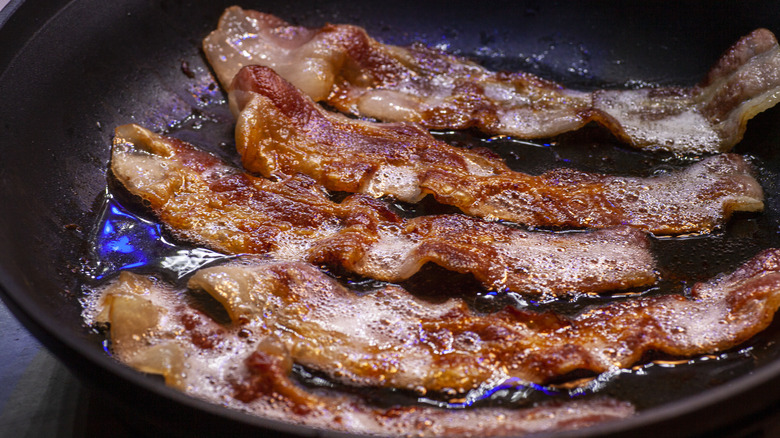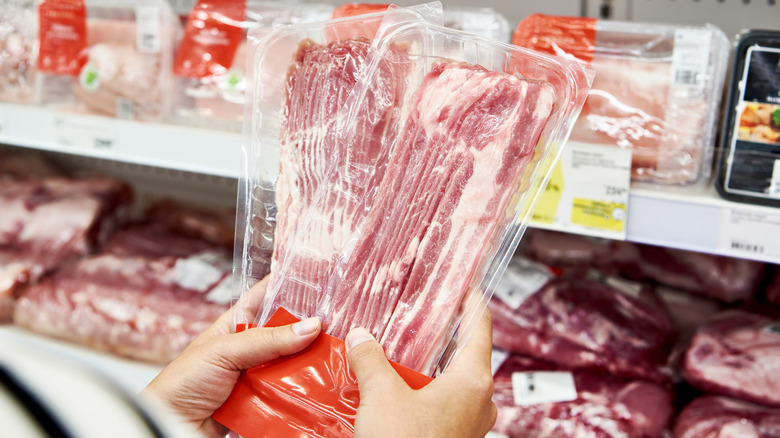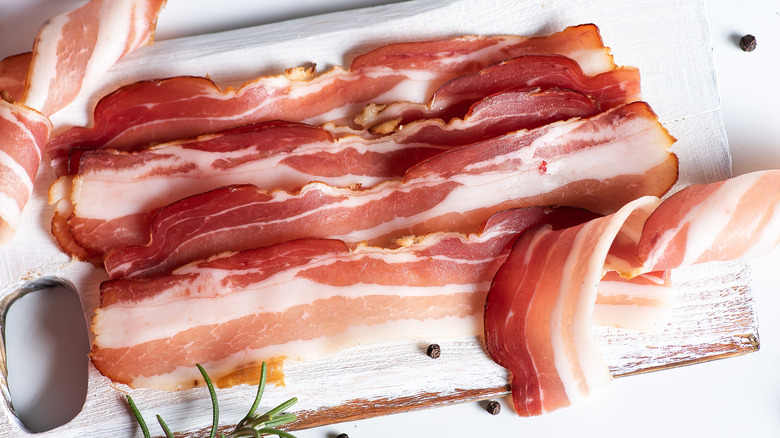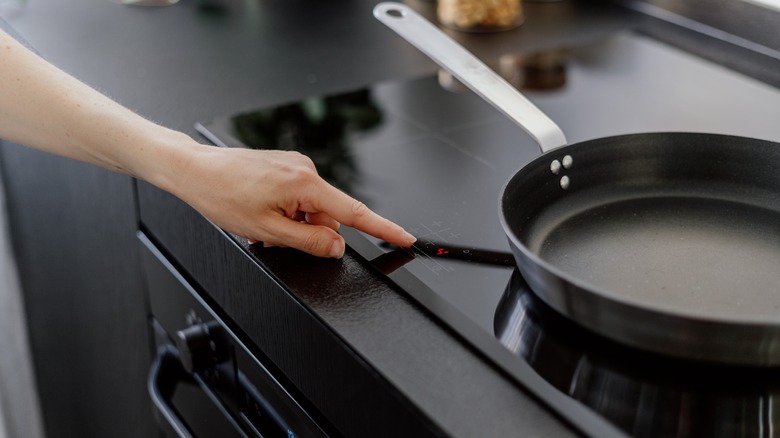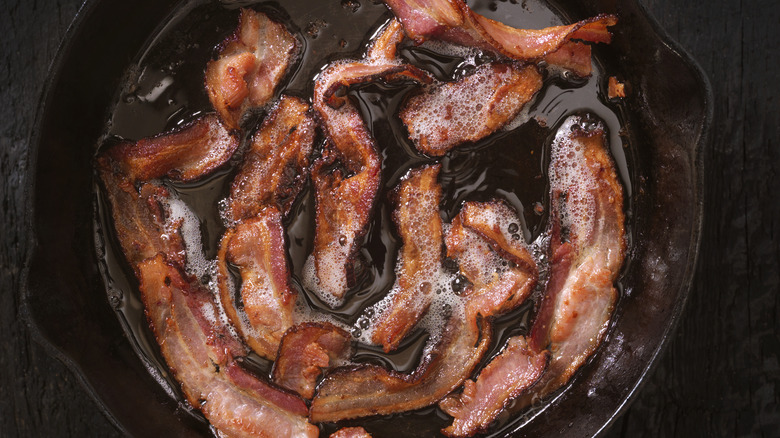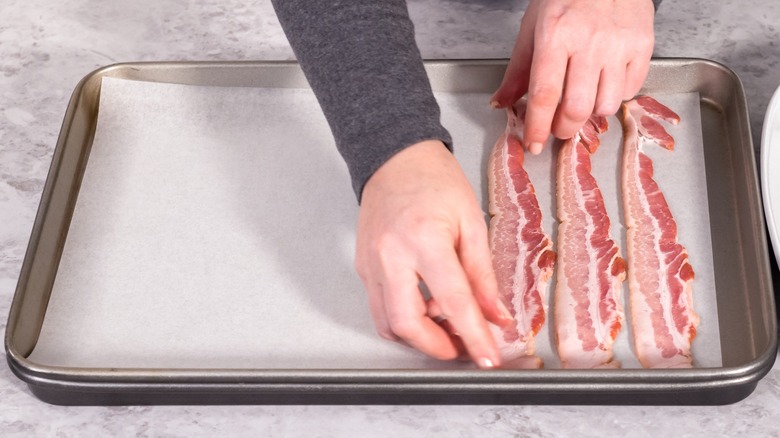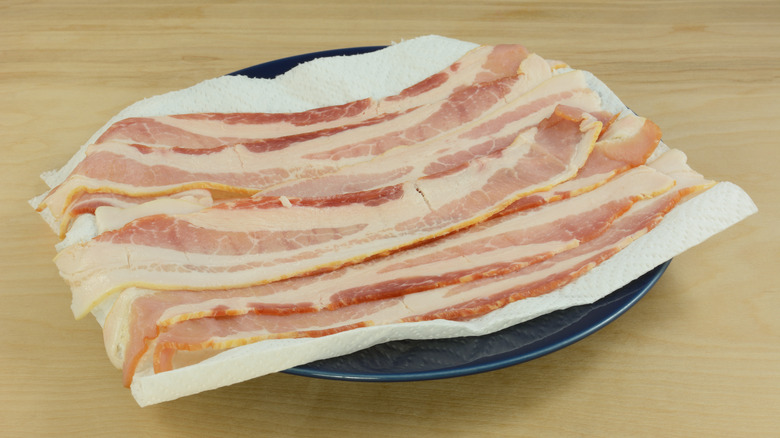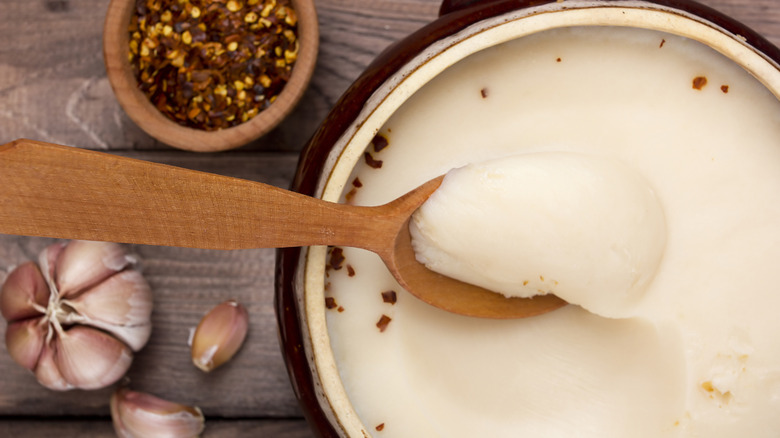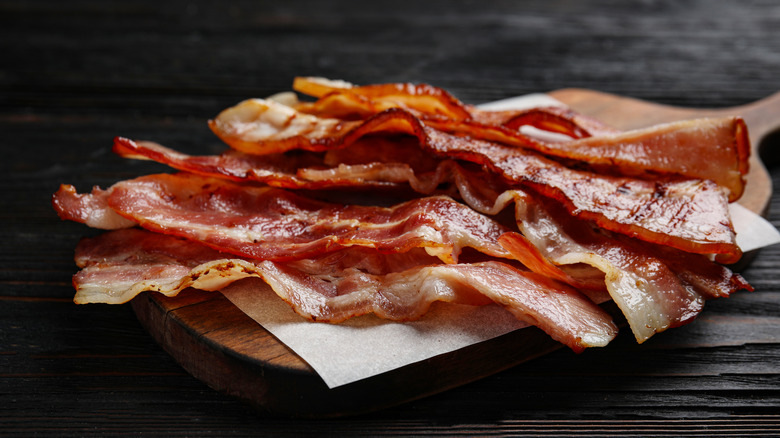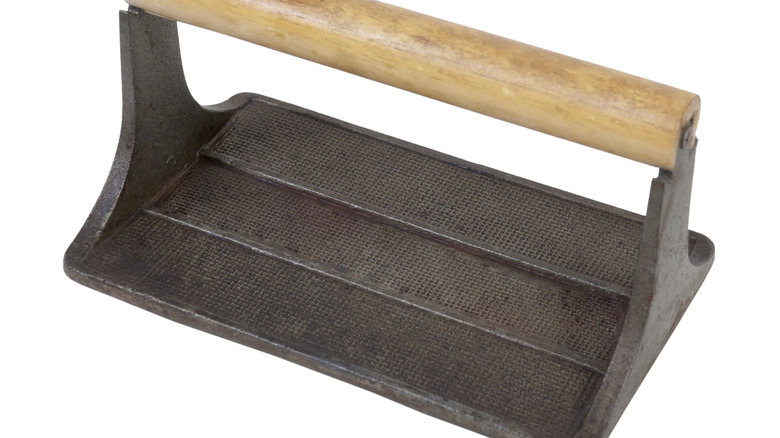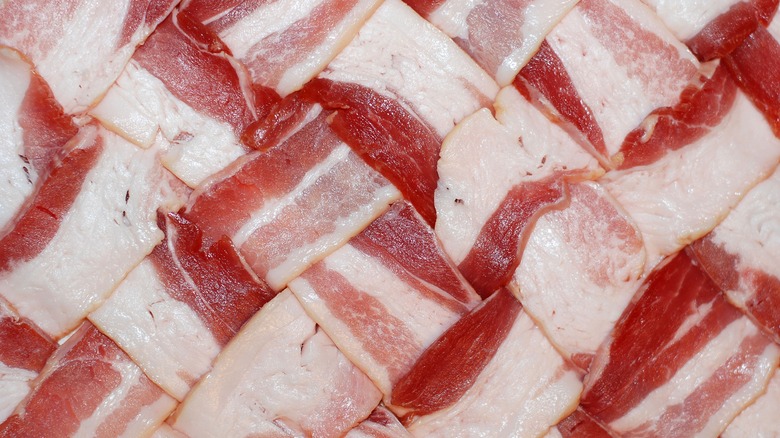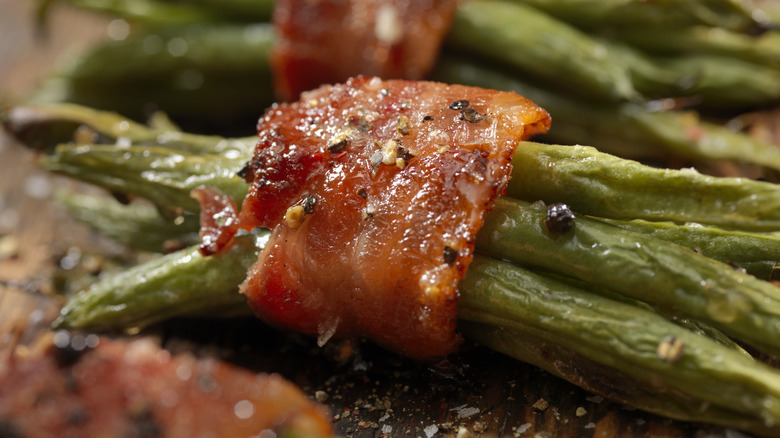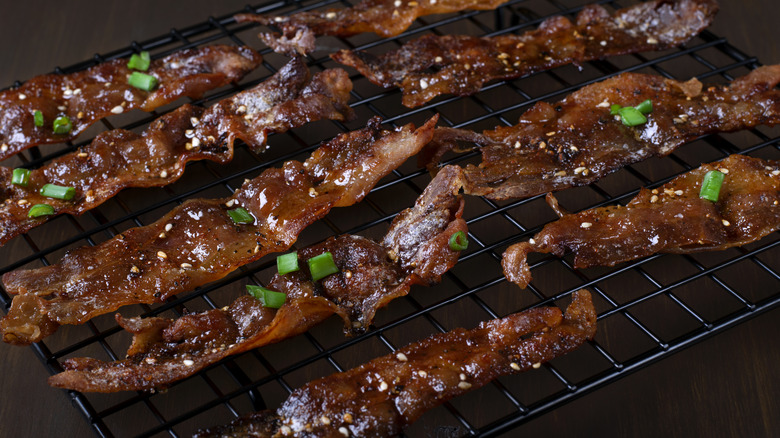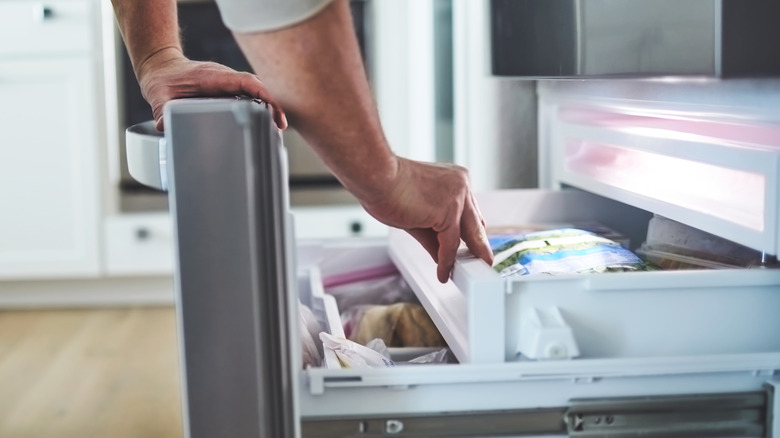13 Tips You Should Know When Cooking Bacon
America's favorite breakfast meat is undeniably bacon. After all, what's better than a steaming plate of your favorite breakfast foods with a side of crispy bacon? Not much, I tell you. And while we love bacon for breakfast, it's also a popular addition to pastas, sandwiches, and even chocolate.
This beloved food is a household staple. People eat bacon in many ways across different countries, but the American version is traditionally long slices of meat from the pork belly cut of a pig. These days, you don't even need to eat pork to enjoy the flavor, texture, and versatility of bacon. Enterprising food brands now offer a variety of bacon options. You can even find vegetarian and vegan choices, such as soy or coconut bacon.
While most of us are pros at eating our favorite breakfast food, there are some simple techniques that any home chef could benefit from when making bacon. Combining my experience cooking for a family of four and information gleaned from scouring the internet, we've compiled 13 essential tips for cooking bacon at home.
Choose the right bacon for the job
When it's time to buy your bacon, you've probably noticed that the grocery store provides an overwhelming array of options. While it might look like all bacon is created equal, the truth is that different types are suited to different jobs.
Traditionally, store-bought bacon is ¹⁄₁₆ of an inch thick. This is ideal if you like your bacon extra crispy. But, if you prefer your bacon chewy and a little on the fatty side, go with a thick-cut option. Thick-cut bacon is usually closer to ⅛ of an inch thick. If you purchase bacon directly from a butcher, you can buy it by the slab and slice to your preference.
If you want a naturally lower-fat bacon, look for the center cut. This bacon comes from the cut closer to the bone and is less fatty than other cuts.
If you have a busy lifestyle and want to save time, grab some fully cooked bacon — this also saves on the cleanup. Fully cooked bacon comes pre-cooked and ready to eat. All you need to do is heat it in the microwave and it's ready to go.
While real bacon is a pork product, you can find myriad bacon options that don't come from a pig. It's nice to have options if you're looking to reduce fat in your diet, feed vegetarians, or just switch up the flavors in your favorite meals (hello, duck bacon!).
Start with room temperature bacon
Ready to make your bacon? You might be surprised to learn that the best-cooked bacon starts at room temperature. Most of us pull the bacon right out of the fridge and throw it in the pan, but a little patience and foresight will result in crispier bacon that cooks more efficiently than its cooler counterparts.
If you're a home chef or handy with the grill, you might already know to let your steak sit for a good 20 minutes or so before cooking it. The same is true with your bacon, and for the same reason.
Take your bacon out of the refrigerator about 15-20 minutes before you cook it and let it warm up a little. When i4bothe the meat and fat hit room temperature the whole strip will cook more evenly and turn out crispier. You'll want to take this extra step no matter what cooking method you plan to use. A small amount of planning to ensure your bacon is at the proper temperature for cooking will help make it as tasty as possible.
Always start with a cold pan and cook on medium heat
You might think getting the pan nice and hot before you cook will help bacon cook faster, but in reality, you'll be sacrificing the taste and quality of the finished product. Always start with a cold pan and cook your bacon on medium heat for the best results.
Have you ever had a slice of bacon that is overdone in some places but soggy and fatty in others? That's all thanks to starting with a hot pan and then cooking at a temperature that's too high. The fat needs to melt away slowly for the most evenly crisp bacon. This is called rendering. A hot pan makes the fat seize, resulting in slices that aren't evenly cooked.
The same is true for the temperature you're cooking with. Too hot, and you'll get unevenly cooked strips with fatty ends. Keep the temperature on medium (or even medium-low) heat, and you'll get flat, crispy, evenly cooked pieces of bacon every time.
Use water to avoid bacon grease splatters
Cooking your bacon in water will reduce grease splatters, but that's not the only reason to try cooking with this method. Cooking bacon in water also keeps the temperature down and helps the bacon cook more evenly, resulting in picture-perfect pieces every time.
Just like you want to start with a cold pan and cook on medium heat to help the fat render slowly, adding water to your pan works similarly and should be something you do every time you make bacon. Depending on how many slices you're making, add a tablespoon or two of water to the pan while the pan is still cool. This simple step doesn't take much effort, and the evenly rendered fat and meat is worth the result.
Thanks to the water, your bacon will cook more slowly and retain some moisture. Because you're using minimal water, your cooking time shouldn't differ much from when you cook without water.
For large amounts of bacon, cook it in the oven
Cooking bacon on the stove in a frying pan is a tried-and-true method, but did you know you can cook it in the oven, too? Cooking bacon in the oven is the perfect solution if you have to cook a large amount at once. It's efficient, and the bacon always turns out just right (no wonder this was Anthony Bourdain's favorite way to cook bacon).
One of the benefits of cooking bacon in the oven is that you can cook a big batch at once. Like when you start with a cold pan, start with a cold oven. Cover a baking sheet with parchment paper or foil and line up the bacon on the sheet. While you don't want to overlap any of the slices, you can line them up right next to each other and should be able to fit a good amount on your tray. Place in the oven and turn the oven on to 400 degrees Fahrenheit.
Check the bacon periodically to ensure it doesn't overcook. It should be ready in about 20 minutes. Once done, remove it from the oven and place it on a plate covered in a paper towel. The paper towel will soak up some grease while the bacon cools.
For bacon in a hurry, stick it in the microwave
There's nothing like a perfectly cooked piece of bacon right out of the pan, but sometimes we don't have the time. Cooking bacon in the microwave is quick and easy and ideal if you're in a hurry.
Be sure to prepare your bacon properly unless you want to spend time scraping greasy bacon splatters off the inside of your microwave (it can be messy). Lay a paper towel over a microwave-safe plate. Lay the bacon on the paper towel side by side. Be sure not to overlap the strips, or they will cook unevenly. Cover with another paper towel (this will keep the grease from splattering all over your microwave).
The general rule is to cook on high for about 1 minute per slice. If you're cooking 3 or 4 slices at a time, you will cook for 3 or 4 minutes. If you have more than 4 slices, start with 4 minutes and then cook in 30-second increments if it doesn't look done.
Remove from the microwave, taking great care as that plate will be super hot. Place the cooked slices on a paper towel to cool.
Always save the grease
The best thing about cooking bacon is, obviously, bacon. But did you know that bacon grease is another amazing bacon-cooking by-product? It can be used for various recipes and is a great addition to vegetables, pasta, biscuits, and even cocktails (if you've never fat-washed a cocktail, here's how).
Storing your bacon grease is an extra step in the cooking process, but it's simple and will pay off when you have the grease on hand for future recipes. All you need is a mason jar and some cheesecloth. Pour your bacon grease into a glass measuring cup with a spout to avoid making a mess. Cover the mason jar opening with the cheesecloth, then slowly pour the grease into the mason jar. The cheesecloth will filter out any bacon pieces.
Alternatively, you can use a coffee filter if you don't have cheesecloth. Put the lid on the jar and store it in your refrigerator for up to three months.
You can use bacon grease instead of oil or butter in most recipes. There are many creative ways to cook with bacon grease – don't be afraid to try something new.
Batch-cook bacon for easy meal prep
Meal prepping saves a ton of time, money, and energy and is a great way to keep eating goals on track. You can now add bacon to your list of meal prep-friendly foods. Batch-cook bacon and reheat it when you need it, making it easy to have on hand for salads, sandwiches, or breakfast on the go.
To batch-cook bacon, cook the full amount you need for the next week. You can cook even more, but you'll need to freeze anything you won't eat within a week. Cooked bacon, when stored correctly in the refrigerator, will keep for about one week. At the end of the week, toss or freeze any leftover cooked bacon.
Once cooked, let the bacon cool completely before storing. Once cool, put parchment paper between each strip (paper towels will also work). Then, store the layered bacon in an airtight container.
When you're ready to eat, reheat using your preferred method. The microwave is the quickest option for reheating your bacon, but instead of heating one minute per slice, reheat for about 15 seconds per slice.
Use a bacon press for flat, evenly cooked bacon
Bacon will naturally curl a little, especially when you cook it in a pan on the stove. But if your goal is to have super straight strips of bacon, it's easily achieved with a bacon press. This tool keeps the bacon flat in the pan or oven, which results in more evenly cooked bacon (no more fatty ends and crispy middles).
Bacon presses are heavy rectangles made of cast iron designed to rest on the bacon while cooking. To create perfectly straight pieces of bacon, start with a cold pan, cook on medium heat, and add a bacon press — you can't go wrong.
A bacon press is a handy tool if you have a hankering for straight bacon, but it can also be used for many other things. When it's not flattening your bacon, use it as a tortilla press or to make smash burgers.
Make a bacon weave for sandwiches and burgers
A bacon weave is several strips of bacon cut down to the size you want and weaved together using a basketweave method. This is a convenient and tasty way to prepare bacon for sandwiches or burgers but you can even use it to make this bacon weave apple pie.
Making a bacon weave is easy. Start with slices of cold, thick-cut bacon. This will be easier to handle than thinner bacon. Lay down some parchment paper or foil to use as your workspace. Using kitchen scissors, cut your bacon to the size you want. Not sure where to start? Start with three slices cut in half if you're making a bacon weave for a sandwich or burger. Then, weave the slices together.
For best results, cook in the oven just like regular bacon strips (because of the overlapping bacon, you may need to cook for a few minutes longer). You can also grill your bacon weave. The final product is a sheet of bacon, the perfect size for your sandwich or burger.
Wrap your favorite ingredients in bacon
Elevate dinner (or breakfast, or lunch) by dressing up your everyday foods in bacon. Bacon is a great wrapper for dates, peppers, chicken breasts, and everything in between. Feel free to get a little adventurous and think outside the box with your cooking – bacon pairs well with all kinds of unexpected ingredients.
Bite-sized, bacon-wrapped fare makes for popular party appetizers that are sure to be a hit. Some foods to wrap in bacon for your next party include mini sausages, scallops, jalapeños, and even water chestnuts.
Choose thin-cut bacon for wrapping. Thick-cut bacon takes a little longer to cook and can end up soggy. You can cut down the bacon to the size you need (if it's too long, it will overlap too much and not cook evenly on the overlap). There will always be some overlap to wrap it completely around the item, but keep it short. Secure with a toothpick to keep the bacon wrapped while cooking. Depending on your appetizer, you can leave the toothpick in for serving.
Make candied bacon for a sweet treat
Love the salty savoriness of bacon but also crave something sweet? You might need to try candied bacon. The sweet and savory treat is next level and can be eaten plain, over a salad, in ice cream, or even as a cocktail garnish. If you've never had candied bacon before, consider this your sign to make some.
It's easy to make candied bacon and is best prepared in the oven. Start with regular or thinly cut slices. Although you can get creative and add ingredients to this recipe (like pepper, maple syrup, and even sriracha), all you need to get started is bacon and brown sugar. You will prep and cook your bacon using the oven method, only you will add an oven-safe wire rack to your baking sheet. Instead of placing your bacon on the baking sheet, you'll place it on the rack.
Once you have your bacon on the rack, add some brown sugar to each slice. The amount of sugar you add will depend on you, but about a teaspoon should do (you can always add more with the next batch). Cooking directions are the same as regular bacon. Make sure to let it cool before tasting it, as the sugar will be scalding hot when it comes out of the oven.
Freeze bacon for later
Have a package of bacon you never quite got around to cooking? Bacon is easy to freeze, so you never need to let it go to waste. However, there are some important guidelines to follow when freezing bacon.
Bacon's high fat content makes it susceptible to turning rancid, even when frozen. It is advised that you only freeze unopened bacon (if your bacon package is already opened but you know you won't eat it, you can cook it and freeze it once cooked to avoid waste). To freeze unopened bacon, wrap the package in foil, be mindful to remove all the excess air, and close the edges tightly. Store in the freezer for up to one month. Thaw the bacon by putting it in your refrigerator a day or two before you need it – do not let it thaw at room temperature.
To freeze cooked bacon, separate the slices with parchment paper and seal them in an airtight container or freezer-safe bag. Cooked bacon can stay in the freezer for two to three months.
